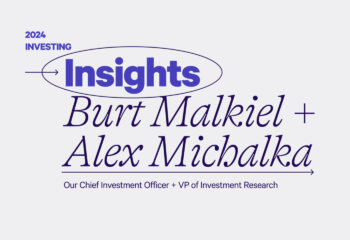Last week Bloomberg reported that the aggregate assets invested in index-based funds surpassed actively managed equity funds for the first time. This comes as no surprise to those of us who have long been promoting the merits of passive investing. Nor did it surprise us when active managers began beating the drum warning of the dangers of a so-called “passive investing bubble” shortly after this news broke. We want to set the record straight: Passive investing is not a communist plot or a nefarious scheme to undermine the investment business. It’s just a better way to invest.
The idea that index investing is superior to active management — stock picking — was first proposed by our Chief Investment Officer Dr. Burton Malkiel and popularized with his groundbreaking book A Random Walk Down Wall Street, first published in 1973. Burt was the first to present evidence that it is extremely difficult to outperform the market over long periods of time if you charge the fees required to fund stock picking research.
This philosophy was difficult for the mainstream to believe, to say the least. It contradicted the very popular investment strategy espoused by perhaps the best-known stock picker of the ‘70s and ‘80s, Peter Lynch, portfolio manager of the wildly successful Fidelity Magellan Fund. Lynch promoted the view that investors should buy stock in the companies whose products they loved. It worked for Magellan, so why wouldn’t it work for everyone?
So why was that approach a great idea for Lynch but not for average investors? It’s because most individual investors make the same crucial mistake: they buy when the market is rising and sell when the market is declining. DALBAR Research has studied this phenomenon for over 40 years and found that this suboptimal strategy — which intuitively feels like the right thing to do — costs the average individual investor somewhere between 1.5% and 3.5% per year. Compounded over time, that represents an incredible loss.
Investment legend Charley Ellis once shared with me the best explanation I’ve ever heard for why it’s so hard to outperform the market. According to Charley (and a lot of academic research), 40 years ago, the vast majority of the money invested in the US stock market was managed by individual investors. Decent professional investors made money just by taking the other side of the aforementioned trade: They bought when stocks declined and sold when stocks rose. According to Charley, it was the equivalent of a good poker player sitting at a poker table with a bunch of rubes. Their success wasn’t based on them having an especially astute investment strategy — it was based on so many other people having an especially poor one.
Fast forward to today where, unlike 40 years ago, the vast majority of the money invested in US stocks is now managed by professionals, which is the equivalent of everyone at the poker table being an expert player. It’s really hard for even professional investors to outperform the markets over long periods of time since they now have to compete with other experts.
I think there are parallels between climate change and the attitudes we see towards passive investing from industry pundits.
Last week on The Daily Show with Trevor Noah, I saw a fascinating interview of 16-year-old Greta Thunberg, an incredibly effective advocate of changes required to combat global warming. When Noah asked her to point to the biggest differences she has observed between the US and her native Sweden, Thunberg replied, “In the US, climate change is a debate. In Sweden, it is taken as a fact.” The same could be said about passive (index-based) investing. I have yet to see any credible research that shows active investment management is a better long-term approach, but that doesn’t stop pundits from developing excuses for its apparent flaws. So-called experts will sometimes declare that a particular market environment is “ideal for stock pickers,” despite there being no peer-reviewed research to support the assertion that market environment impacts the efficacy of passive investing.
So let’s speak about that mythical “passive investing bubble.”
Another favorite argument of detractors is that passive investing will stop being effective as its share of investing increases. Three years ago, Burt Malkiel wrote a wonderful blog post debunking this hypothesis. The basic premise is this: stocks will continue to be accurately priced as long as only 5% to 10% of the market remains active. If equity markets aggregate $40 trillion of value, then $2 to $4 trillion should be enough capital to overcome any issues created by index funds.
Finally, some people have argued that index funds lead to greater market volatility. Again, there is no academic research to back this up.
I must confess that I was a die-hard active management advocate before seeing the light and subsequently starting Wealthfront. I built my career as a venture capitalist, which, in a way, made me a “stock picker” of private companies. I strongly believed the same active approach could be applied successfully to public stocks. I was simply swayed by the overwhelming data that has proven otherwise.
Passive investing is a boon to investors because it requires far less time and leads to much better outcomes. It is no surprise that it now represents the majority of the equity fund market. Any concerns about potentially negative consequences stemming from too many people adopting this proven-superior approach are as unfounded as the arguments against passive investing itself.
Disclosure
This blog is powered by Wealthfront Advisers LLC (“Wealthfront Advisers”). The information contained in this blog is provided for general informational purposes only, and should not be construed as investment advice. Nothing in this communication should be construed as an offer, recommendation, or solicitation to buy or sell any security or a financial product. Any links provided to other server sites are offered as a matter of convenience and are not intended to imply that Wealthfront Advisers or its affiliates endorses, sponsors, promotes and/or is affiliated with the owners of or participants in those sites, or endorses any information contained on those sites, unless expressly stated otherwise.
Investment advisory services are provided by Wealthfront Advisors LLC (“Wealthfront Advisers”), an SEC-registered investment adviser, and brokerage products and services, are provided by Wealthfront Brokerage LLC (formerly known as Wealthfront Brokerage Corporation), member FINRA / SIPC. Wealthfront Software LLC (“Wealthfront”) offers a free software-based financial advice engine that delivers automated financial planning tools to help users achieve better outcomes.
All investing involves risk, including the possible loss of money you invest, and past performance does not guarantee future performance. Please see our Full Disclosure for important details.
Wealthfront Advisers, Wealthfront Brokerage and Wealthfront are wholly owned subsidiaries of Wealthfront Corporation.
© 2019 Wealthfront Corporation. All rights reserved.
About the author(s)
Andy Rachleff is Wealthfront's co-founder and Executive Chairman. He serves as a member of the board of trustees and chairman of the endowment investment committee for University of Pennsylvania and as a member of the faculty at Stanford Graduate School of Business, where he teaches courses on technology entrepreneurship. Prior to Wealthfront, Andy co-founded and was general partner of Benchmark Capital, where he was responsible for investing in a number of successful companies including Equinix, Juniper Networks, and Opsware. He also spent ten years as a general partner with Merrill, Pickard, Anderson & Eyre (MPAE). Andy earned his BS from University of Pennsylvania and his MBA from Stanford Graduate School of Business. View all posts by Andy Rachleff



